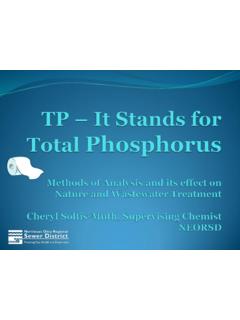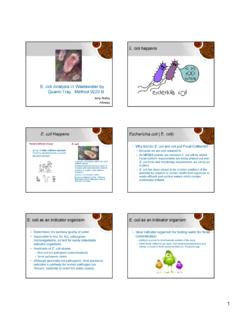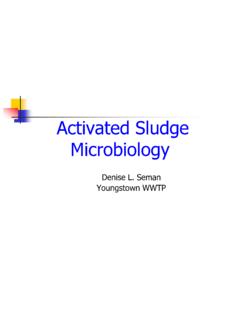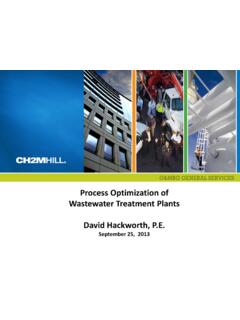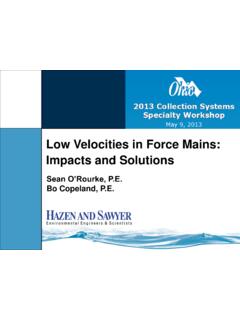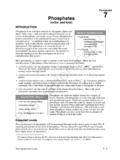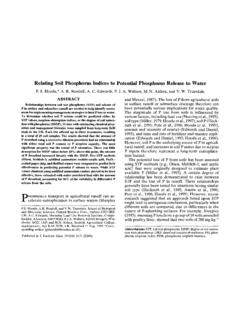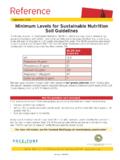Transcription of Optimizing Chemical Phosphorus Removal
1 Optimizing Chemical Phosphorus Removal JB Neethling HDR Engineering 2013 Technical Conference and Exposition Ohio Water Environment Association (OWEA) Mason, OH June 18-20, 2013 Copyright 2013 HDR Engineering, Inc. All rights reserved. Agenda Chemical Phosphorus Removal Basics Phosphorus Species Performance Opportunities for Optimization Phosphorus Species total P Dissolved P Particulate P Ortho P (Reactive P) Inorganic Condensed P Soluble Organic P Particulate Acid Hyd P Particulate Organic P Particulate Reactive P Fundamental Principle of Phosphorus Removal There is no airborne (gaseous) form of Phosphorus Fundamental Principle of Phosphorus Removal The exception There is no airborne (gaseous) form of Phosphorus Convert to Particulate Particu-late P Soluble P Particu-late P SolP Liquid Solid Typical Chemical Treatment Opportunities Primary Secondary Tertiary Polish Solids Processing Chemicals used for Phosphorus Precipitation Chemical Formula Removal mechanism Effect on pH Aluminum Sulfate (Alum) Al2(SO4) (H2O) = Metal hydroxides removes alkalinity Ferric Chloride FeCl3 = Metal hydroxides removes alkalinity Poly Aluminum Chloride AlnCl(3n-m)(OH)m Al12Cl12(OH)24 Metal hydroxides none Ferrous sulfate (pickle liquor) Fe2SO4 Metal hydroxides Removes alkalinity Lime CaO, Ca(OH)
2 2 Insoluble precipitate Raises pH to above 10 Ferric Reaction with Phosphorus The following illustrates a stoichiometric reaction of Fe+++ with P 1 mole of Fe reacts with 1 mole P mg ferric per mg P mg alkalinity per mg of ferric FeCl3 + H3PO4 = FePO4 + 3 HCl3 Alum Reaction with Phosphorus Al2(SO4) + 2H3PO4 2 AlPO4 + 3H2SO4 + 18H2O The following illustrates a stoichiometric reaction of Al+++ with P 2 mole of Al reacts with 2 mole P (or 1 mole Al per mole P) mg alum per mg P mg alkalinity per mg of Alum Phosphorus Removal Chemical Dose Phosphorus Concentration Initial Removal - Stoichiometric 1:1 Equilibrium control need higher dose Break ~ 1 mg/L Molar Dose Ratio From Tests Slav Hermanowicz, Chemical Fundamentals of Phosphorus Precipitation, WERF Boundary Condition Workshop, Washington DC, 2006 P res (mg/L)Al/P (mol/mol)Full Scale - data pH 6 Lab data pH P res (mg/L)Fe/P (mol/mol)
3 Lab data pH data pH data pH data pH 8 Full Scale dataExact Molar Ratios Versus Effluent Soluble P will Vary with Applications to Molar ratios for 80-98 percent Removal to Molar ratios for higher efficiency and to reach low minimal soluble P concentrations Ratios are higher with PAC Factors that influence ratios pH Mixing method Wastewater characteristics Colloids and solids effect P-metal hydroxide complexations Organic subtrates Iron and aluminum can react with humic substances Kinetics and Mixing of Phosphorus / Alum Reaction Szab et al. (2006) The Importance Of Slow Kinetic Reactions In Simultaneous Chemical P Removal , WEFTEC 2006 Photomicrographs of Phosphate Precipitants pH 7--> pH 3 Scott Smith, Wilfrid Laurier University Fresh HFO Scott Smith, Wilfrid Laurier University Young HFO Scott Smith, Wilfrid Laurier University FePO4 precipitant After 4 days.
4 Aged HFO HFO precipitant After 2 years. Hard !! Scott Smith, Wilfrid Laurier University Metal Hydroxide Removal of P Found for Ferric Addition Metal hydroxide formed Co precipitation of P into hydrous ferric oxides structure Fe(OH)3, Fe(OH)4- Surface complexation between P and metal hydroxide compounds Phosphorus and Iron share oxygen molecule: FeOOH + HOPO3 = FeOOPO3 + H2O Hydroxide formation can be simply represented: FeCl3 + 3H2O => Fe(OH)3 + 3 HCl Al2(SO4) + 3 H2O => 2Al(OH)3(s) + 3H2SO4 Closer Look at the Chemical Species 33 L. Liu, D. S. Smith, D. Houweling Neethling, Stensel S. Murthy, Amit Pramanik and A. Z. Gu Phosphorus Speciation and Removal in Advanced Wastewater Treatment Analytical Definitions of Phosphorus Species Filterable/nonfilterable (soluble?)
5 Passing through filter paper Could be colloidal (very small particles) Reactivity to analytical procedure Measure for orthophosphate Pretreatment (acid hydrylosis, digestion, etc) Convert larger molecules to be reactive (orthophosphate) Phosphorus Species Categories total P Dissolved P Particulate P Ortho P (Reactive P) Inorganic Condensed P Soluble Organic P Particulate Acid Hyd P Particulate Organic P Particulate Reactive P Particulate Chemical Precipitant Measures as Reactive P Combine d Se condary Efflue nt- Jar Te sting Re Dose-Al2(SO4) (m g/L)Effluent ortho-P (mg/L)P in= ilteredAnalytical Definition Based Phosphorus Fractions/Species total P Dissolved P Particulate P Sol Reactive P SRP PRP Sol Acid Hydrolyzable Sol Dig.
6 Part Acid H. Particle Digestible Method Colloidal P Ortho P Inorganic Condensed P Sol Org Chemical particulate P Particulate Organic P Nonreactive Phosphorus total P Dissolved P Particulate P Sol Reactive P SRP PRP Sol NonReactive P SNRP Particulate NonReactive P total Reactive P total NonReactive P Analytical Definition Based Phosphorus Fractions/Species total P Dissolved P Particulate P Sol Reactive P SRP Sol Non Reactive P sNRP Colloidal P Ortho P Acid Hydrolyzable P Sol Org Part Chemical P Part Organic P Secondary Effluent TSS adds to Particulate NRP 0204060801001201401600123456 Particulate Nonreactive Phosphorus , ug/LTSS, 5 3% Filtered Effluent TSS adds to Particulate NRP Nonreactive Phosphorus , ug/LTSS, ug/L 1 mg/L 3% Pilot Study Results Illustrated Challenges at Limits of Technology [mg/L]sRPsNRPpP No Treatment Technology Available for SNRP Portion May Not Be Bioavailable / Biodegradable Particulate P Soluble NonReactive P Soluble Reactive P Neethling et al, 2007 Effluent P Fractions From Advanced Tertiary Treatment Processes Concentration, mg/L pAHPpOPpRPsAHPDOPsRPSedimentation Filtration Membrane Filtration Lui, Gu, et al.
7 (ongoing) Phosphorus Speciation and Removal in Advanced Wastewater Treatment, WERF Report P fractions at Plant N INFBNRC hemical PremovalMono/DualmediaFiltrationP concentration (mg/L) sAHP seems to remain after BNR, associated with biomolecules Chemical addition converts sRP into pRP Chemical sRP (PO4) Removal relies pRP Removal Comparison of P fractions at Plant P 0123456789 BNR INFBNRT rident HSP concentration (mg/L) Plant P and N are similar as (BNR+sedimentation +Filtration): composition very different DOP dominant soluble fraction; pAHP major particulate form Multi stage barrier remove TP to lower level BNR Eff Opportunities for Optimization Opportunities for Improvement Improve understanding of Chemical kinetics Dose relationships Reuse formed metal hydroxides Enhance solids separation Molar Dose Ratio From Tests Slav Hermanowicz, Chemical Fundamentals of Phosphorus Precipitation, WERF Boundary Condition Workshop, Washington DC, 2006 P res (mg/L)Al/P (mol/mol)Full Scale - data pH 6 Lab data pH P res (mg/L)Fe/P (mol/mol)
8 Lab data pH data pH data pH data pH 8 Full Scale dataSingle Step Chemical Addition Requires High Dose One Step P entering mg/L 5 P residual mg/L Alum/P dose mol/mol 5 Alum/P dose mg/mg 48 Alum dose mg/L 235 Two Step Chemical Addition Reduce Dose One Step Step 1 Step 2 Two Steps P entering mg/L 5 5 1 5 P residual mg/L 1 Alum/P dose mol/mol 5 5 Alum/P dose mg/mg 48 14 48 21 Alum dose mg/L 235 58 43 101 Two Step Chemical Addition Reduce Dose One Step Step 1 Step 2 Two Steps P entering mg/L 5 5 1 5 P residual mg/L 1 Alum/P dose mol/mol 5 5 Alum/P dose mg/mg 48 14 48 21 Alum dose mg/L 235 58 43 101 Reuse Chemical Sludge to Reduce Dose and Increase Reliability Return Chemical sludge to upstream process Build solids inventory operate in solids contact mode Conventional Tertiary Chemical P Removal AS SCL SCL PCL Al/Fe Filter Al/Fe ReUse Chemical Sludge Upstream AS SCL SCL PCL Al/Fe Filter Al/Fe Contact Clarification in Tertiary AS SCL SCL PCL Al/Fe Filter Al/Fe ANX Coeur d Alene.
9 Microfiltration and Solids Recycle AS SCL PCL Al/Fe Al/Fe ANX TMF Implications for Design and Operation Coeur d Alene Pilot No Solids Inventory Loss of Alum feed Implications for Design and Operation Coeur d Alene Pilot With Solids Inventory PO4-P [mg/L] PO4-P [mg/L] TMF Effluent PO4-PSecondary Effluent PO4-PAlum Off Alum On Summary and Conclusion - I Chemical reactions for Phosphorus Removal with ferric or alum is a primarily a surface complexation reaction Good mixing and contact time is needed to maximize Chemical efficiency Preformed Metal Hydroxides retain the ability to react and remove phosphate Summary and Conclusion - II Target Phosphorus species for effective Removal : Precipitate Reactive Phosphorus Phosphate Increased dose can improve Removal Filter particulate fractions High efficiency filters Soluble Non-Reactive P remains difficult to remove Reuse metal hydroxides to reduce Chemical use Optimizing Chemical Phosphorus Removal JB Neethling HDR Engineering 2013 Technical Conference and Exposition Ohio Water Environment Association (OWEA) Mason, OH June 18-20, 2013 Copyright 2013 HDR Engineering, Inc.
10 All rights reserved.
